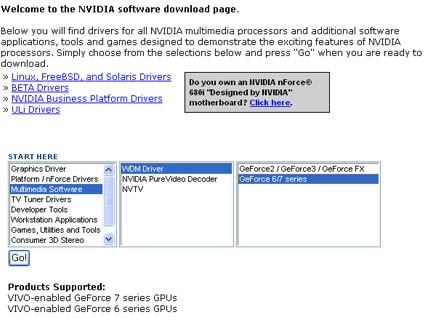Video Capture: Available On AMD, Sometimes On Nvidia
Closing Thoughts: Que Pasa?
The WDM drivers are available on Nvidia's Website. In the driver section, select Multimedia software and the proper menus will become available.
It does not surprise me that current sales data indicates that many people do not use the video capture capabilities of their graphics cards. If there is only a composite and/or S-video in connection, there is no option for recording high definition content. Add-in cards can capture cable television programs, and AMD even has an HDTV receiver for broadcast television. I highly doubt, however, that there are droves of people who want to record from broadcast transmissions - there can be a lot of noise from interference to the transmission. On the other hand, the image quality of composite and S-Video is inferior to that which one can capture.
If you are like me, you like to copy kids' DVDs; I mean, let's face it: kids are kids. This way, they can play their movies and still be kids. If the DVD breaks, is scratched, or whatever else they may do to it, all is not lost as I still have the original.
However, if I bought a graphics card for a pretty penny, I would like it to have all of the functionality available. In the case of the GeForce 8800GTX and GTS graphics cards, the functionality was not built into the reference design, which I personally dislike. I think a $400 or $600 card should have as many features as possible, not just playback.
That being said, what we can see for the future of video capture on consumer graphics cards is very cool. AMD, under the ATI brand name, released the ATI TV Wonder Digital Cable Tuner. It is a digital cable conversion set top box that allows your PC to receive all of the premium content from service providers such as HBO, Cinemax, and ESPN. Now that is a step in the right direction. For busy people, their HTPC (Home Theater PC) can record favorite shows and play them back at a more convenient time.
On a bad note, digital rights management (DRM) is the craziest thing to hit PCs, as Hollywood tries to tighten its grip on the digital content market. In its incessant attempts to control its content and how users can enjoy it, DRM will require users to have a decoding device, graphics device and DRM enabled display. That means that you will need to buy three pieces of hardware to play a single movie. Hmm... do the math. It could cost several thousands of dollars just to play a $20 movie. That is asinine.
Microsoft has a program called Movie Maker that is available for those who own the Windows XP operating system. It is a free program that allows users to author and edit their own content. Users can capture or take existing still and motion content and make something much more professional out of it. While it is not the "best" option available for users, it is free.
Get Tom's Hardware's best news and in-depth reviews, straight to your inbox.
Microsoft, like many other firms, is catering to Hollywood. Microsoft's website states that "Protected digital media files cannot be imported into Windows Movie Maker." On the heels of the DRM issues, Movie Maker will no longer be able to capture video under Vista. "Windows Movie Maker no longer supports importing video from a Web camera or analog video source such as a VCR. To use video from your Web camera, use the software that comes with the camera to record the video to your computer, and then import the resulting video file into Windows Movie Maker."
While DRM is with us, a new delivery specification will make video capture on consumer graphics cards something worthwhile. Its name is the High Definition Multimedia Interface (HDMI). The first graphics cards have started shipping with HDMI output, but it will only be a matter of time before HDMI-in will be a reality. Then, all of the resolution and sound components of your favorite content will be available to decode and record via your graphics card. It will only be a matter of time before HDMI will be the standard for display, audio, and video devices.
For now, if you are interested in capturing video on a consumer card, check what the box says. If you got a cable with your card that has a port for S-Video or composite in, it may or not work. If it is from ATI and says AVIVO on the box, it should work, but Nvidia cards can be tricky. Some cables have made it into boxes of cards that do not have the functionality enabled. Below is a list of four cards I tested that had video in functionality.
| Company | Chipset | Model | Video In Options |
|---|---|---|---|
| Asus | 7800GTX | N7800GTX TOP | Composite and S-Video In |
| EVGA | 7800GT | 256-P2-N515-AX | Composite and S-Video In |
| PNY | 7800GTX | VCG7800XXWB | Composite and S-Video In |
| XFX | 7900GT | PV-T71G-UCP7 | Composite Video In |
The future is bright for video capture. However, if you own a graphics card without the means to capture the data you are not missing out on much right now; after all, 640x480 video is something my 5-year-old digital camera can do - it is not the choice of the next generation. So while AMD and Nvidia did not comment on future products, you should be on the outlook for new things in digital capture.
Current page: Closing Thoughts: Que Pasa?
Prev Page I Spent $600 On A Graphics Card But It Can't Capture Video?